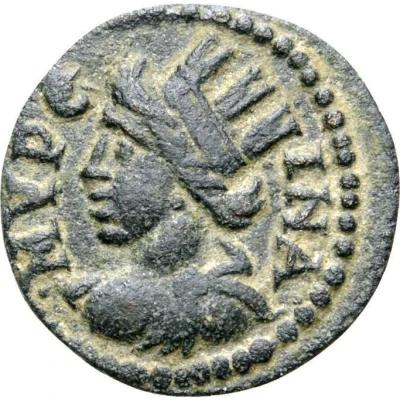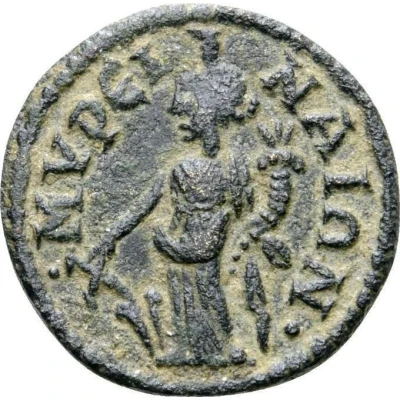


Assarion ΜΥΡΕΙΝΑΙΩΝ
| Bronze | 2.65 g | 18.5 mm |
| Issuer | Myrina (Conventus of Smyrna) |
|---|---|
| Emperor | Valerian (Publius Licinius Valerianus) (253-260) Gallienus (Publius Licinius Egnatius Gallienus) (253-268) |
| Type | Standard circulation coin |
| Years | 253-268 |
| Currency | Antoninianus, Reform of Caracalla (AD 215 – 301) |
| Composition | Bronze |
| Weight | 2.65 g |
| Diameter | 18.5 mm |
| Thickness | 2.05 mm |
| Shape | Round (irregular) |
| Technique | Hammered |
| Orientation | Coin alignment ↑↓ |
| Demonetized | Yes |
| Updated | 2024-10-10 |
| Numista | N#389662 |
|---|---|
| Rarity index | 95% |
Reverse
Tyche standing left, holding rudder and cornucopia.
Script: Greek
Lettering: •ΜΥΡЄΙΝΑΙΩΝ•
Edge
Rough
Comment
This type is often dated from the time of Valerian and Gallienus, following a suggestion made in BMC (BMC 41). The last coins of Myrina with imperial portraits date however from the reign of Gordian III, so a later date seems unlikely. Letter forms are quite similar to RPC VII.1, 294, so these coins have been inserted here.
@RPC Online
These coins were published on the Greek island of LESBOS , convent of SMYRNE, EOLIDE , city of MYRINA under Valerian I (253- 260) and under Gallienus (260-268).
Myrina was one of many predominantly Ionian cities that attributed their foundation to the Amazons, along with Smyrna, Sinope, Kyme, Gryne, Ephesus, Pitania, Magnesia, Clete, Pygela, Latoreria and Amastris. On this coin, we see the Amazon Myrina depicted in a characteristic way with her chest uncovered, associated with the Amazons. The turreted crown confuses her with Tyche, alluding to the mythical founding of the city.
Interesting fact
One interesting fact about this coin is that it features the image of a dolphin on its reverse side, which was a symbol of the city of Myrina. The dolphin was considered a sacred animal in ancient Greece and was often associated with the god Apollo. The inclusion of this image on the coin highlights the cultural and religious significance of the city and its connection to the broader Greek world.